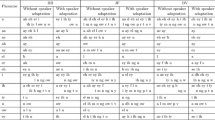Abstract
Articulation errors are common in children but may also persist in adulthood. These errors decrease the speech intelligibility and hamper the ability of a person to communicate properly. A speech language pathologist carefully examines the speech to identify the articulation error patterns. It is exhaustive and time consuming process. This information about the patterns of articulation disorders is then used in treatment. In this paper, a noble approach has been presented to automatically detect the articulation error patterns in Punjabi speech. To provide support for hearing impaired people, a picture naming task has been developed. The proposed tool processes recorded spoken words and outputs the articulation error patterns i.e. substitution and omission of particular phonemes and their position in the spoken word. The basic principles of speech word recognition are used to establish the articulation errors in speech samples. The rigorous experimentation has shown that the proposed tool is accurate in identifying the articulation error patterns in controlled environment.


















Similar content being viewed by others
References
Baig, M., Masud, S., & Awais, M. (2006). Support vector machine based voice activity detection. In International Symposium on Intelligent Signal Processing Communications, Yonago (pp. 319–322).
Bardidehl, M., Razzazii, F., & Ghassemian, H. (2007). An SVM based confidence measure for continuous speech recognition. In International Conference on Signal Processing Communications, Dubai (pp. 1015–1018).
Bauman-Waengler, J. (2004). Articulatory and phonological impairments: A clinical focus (2nd ed.). Boston, MA: Pearson Publications.
Bernthal, J. E., Bankson, N. W., & Flipsel, P. (2008). Articulation and phonological disorders (6th ed.). Boston, MA: Pearson Publications.
Chang, C., & Lin, C. (2011). LIBSVM: A library for support vector machines. ACM Transactions on Intelligent Systems and Technology, 2, 1–27.
Chang, C.-C., & Lin, C.-J. (2001). LIBSVM: A library for support vector machines. Software available at http://www.csie.ntu.edu.tw/~cjlin/libsvm.
Chaudhari, U. V., & Picheny, M. (2009). Articulatory feature detection with support vector machines for integration into ASR and phone recognition (pp. 93–98). Merano: IEEE Work in Automatic Speech Recognition and Understanding, IEEE.
Chen, Y.-J. (2011). Identification of articulation error patterns using a novel dependence network. IEEE Transactions on Biomedical Engineering, 58, 3061–3068.
Cohen, I. (2004). Speech enhancement using a noncausal a priori SNR estimator. Signal Processing Letters, 11, 725–728.
Dinz, P. S., Da Silva, E. A., & Netto, S. (2010). Digital signal processing: System analysis and design (2nd ed.). Cambridge: Cambridge University Press.
Elkins, A. C. (2011). Vocalic markers of deception and cognitive dissonance for automated emotion detection systems. Tuscon (AZ): The University of Arizona.
Ephraim, Y., & Malah, D. (1985). Speech enhancement using a minimum mean-square error log-spectral amplitude estimator. IEEE Transactions on Acoustics, Speech and Signal Processing, 33, 443–445.
Ganapathiraju, A., Hamaker, J. E., & Picone, J. (2004). Applications of support vector machines to speech recognition. IEEE Transactions on Signal Processing, 52, 2348–2355.
Georgoulas, G., Georgopoulos, V. C., & Stylios, C. D. (2006). Speech sound classification and detection of articulation disorders with support vector machines and wavelets. In 28th Annual International Conference of the IEEE Engineering in Medicine and Biology Society, New York, NY (pp 2199–2202).
Hu, Y., & Loizou, P. C. (2006). Subjective comparison and evaluation of speech enhancement algorithms. In IEEE International Conference on Acoustics, Speech and Signal Processing, Toulouse (pp. I153–I156).
Kaklauskas, A., Vlasenko, A., Seniut, M., & Krutinis, M. (2009). Voice stress analyser system for E-testing. Riga: Ninth IEEE International Conference on Advanced Learning Technologies, IEEE.
Muda, L., Begam, M., & Elamvazuthi, I. (2010). Voice Recognition Algorithms using Mel Frequency Cepstral Coefficient (MFCC) and Dynamic Time Warping (DTW) Techniques. Journal of Computing, 2, 138–143.
Natarajan, V. A., & Jothilakshmi, S. (2012). Segmentation of continuous speech into consonant and vowel units using formant frequencies. International Journal of Computer Applications, 56, 24–27.
Patel, K., & Prasad, R. K. (2013). Speech recognition and verification using MFCC. International Journal of Emerging Science and Engineering, 1, 33–37.
Rickie, A. D. (2006). Automatic frame length, frame overlap and hidden Markov model for speech recognition of animal vocalizations. Milwaukee, WI: Marquette University.
Schuller, B., Rigoll, G., & Lang, M. (2004) Speech emotion recognition combining acoustic features and linguistic information in a hybrid support vector machine-belief network architecture. In IEEE Interantional Conference on Acoustics, Speech, and Signal Processing (pp. 577–580).
Sonkamble, B. A., & Doye, D. D. (2008). An overview of speech recognition system based on the support vector machines. In International Conference on Computer and Communication Engineering, IEEE, Kuala Lumpur (pp. 768–771).
Vir, D. (2010). Punjabi articulation test. Patiala, India: Punjabi University.
Author information
Authors and Affiliations
Corresponding author
Rights and permissions
About this article
Cite this article
Singh, S., Thakur, A. & Vir, D. Automatic articulation error detection tool for Punjabi language with aid for hearing impaired people. Int J Speech Technol 18, 143–156 (2015). https://doi.org/10.1007/s10772-014-9256-2
Received:
Accepted:
Published:
Issue Date:
DOI: https://doi.org/10.1007/s10772-014-9256-2




